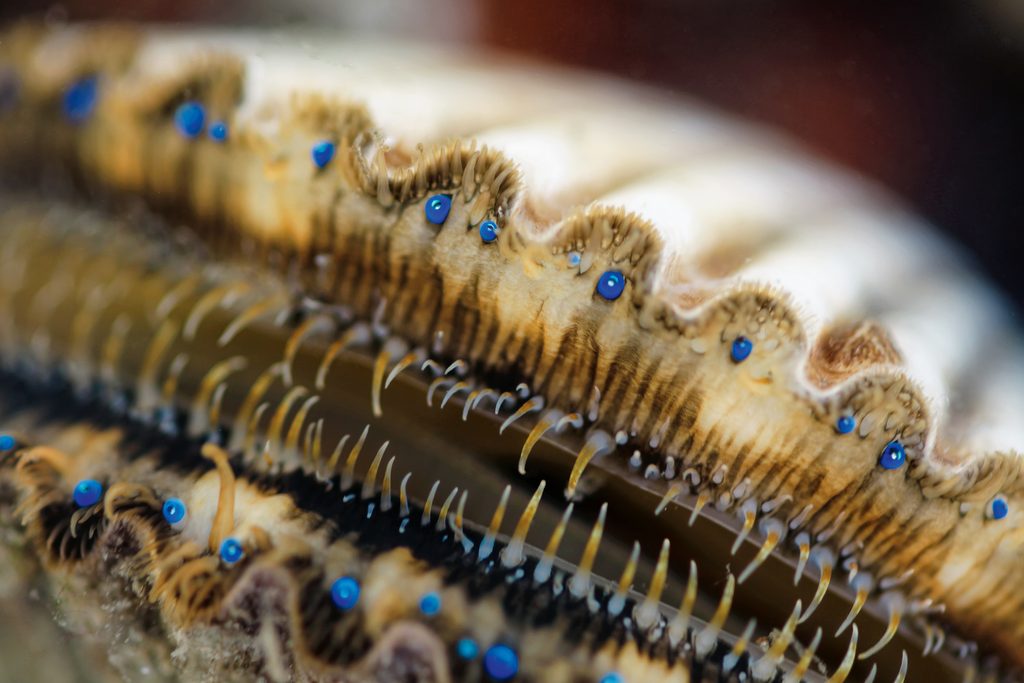
Biologist Dan Speiser ’03 studies marine invertebrates to determine how they make sense of the world.
What has 200 eyes, no brain, swims the breaststroke, and tastes great with butter?
Dan Speiser ’03 has the answer—and then some.
An associate professor of biology at the University of South Carolina, Speiser is one of a growing number of scientists in the emerging field of sensory ecology, which focuses on how nonhuman species perceive their environment, often in ways that defy human comprehension. His specialty is marine invertebrates, notably scallops. “I’m trying to learn how some of the most alien animals perceive the world through their eyes and brains. I’m charmed by these weird animals,” says Speiser, who also studies crabs, shrimp, and insects.
The 41-year-old, who grew up in East Lansing, Michigan, used to regard scallops as merely “lumps of meat” in the freezer section of the local grocery store. He would come to learn, however, that people eat only the scallop’s adductor muscle, which it uses to open and close its shell to filter food particles. A member of the phylum Mollusca family, scallops swim by squirting jets of water out of both sides of its hinge—what Speiser calls the “clap-and-glide” technique. (A biology major at Carleton, Speiser did freestyle and butterfly sprints on the varsity swim team. “Like the scallops I study, I was a high-effort, low-efficiency swimmer,” he jokes.)
As many as 200 primitive eyes, which look like unblinking neon blueberries, are arrayed around the rim of a scallop’s shell. The creatures have no brains, only collections of nerves called ganglia, and Speiser has spent his career endeavoring to understand how its eyes, tentacles, and ganglia work together to process information and transfer it into behavior.
While working on a PhD in biology at Duke in the late aughts, he created what he dubbed Scallop TV. The homemade production centered around a little tank with water flowing in it like an exercise swimming pool and in which Speiser glued a scallop to a chair cut from white PVC pipe. A computer screen outside the tank showed the scallop movies of food particles passing in the same direction as the water in the tank. When its dozens of eyes saw something to eat, the scallop would open its shell to catch the food.
“I thought this was the dumbest idea in the world and that it would never work, but it did,” says Speiser’s thesis adviser, Duke biology professor Sonke Johnsen. “For me it was a Star Wars–type moment, where the pupil became the master. Dan is a scientist’s scientist. He’s a true believer in exploration and the crazy aspects of science. He has the desire to see things nobody has seen before.”
Despite his adviser’s praise, Speiser is now a bit embarrassed by the experiment. “We weren’t asking the right questions,” he says. In fact, the TV test led him to falsely conclude that the scallop was behaving in a kind of knee-jerk fashion, without “thinking.”
In a more recent experiment at the University of South Carolina, he and doctoral student Dan Chappell created a visual stimulus that rotated around a scallop from right to left. When this happened, its tentacles and eyes followed the motion in a wave-like fashion. “The experiment told us that instead of having separate visual alarm systems, a scallop integrates information from all of its eyes. It appears to construct a visual environment from many separate images, and it somehow does this with not much mental processing capacity. The scallop is telling us that it sees for real,” Speiser says.
“Every animal has its own way of sensing the world, its own umwelt, and they show us that our way of experiencing the world is limited,” says Ed Yong, a science reporter for The Atlantic, who wrote the recent bestseller, An Immense World: How Animal Senses Reveal the Hidden Realms Around Us. “Here’s a creature whose eyes are not better than ours, and it forces us to stretch our imaginations in a new, powerful way that enriches our understanding of the world.”
Speiser’s love affair with bizarre creatures began as a child, when he remembers defending his parents’ garden from slugs with bowls of cheap beer. During his second year at Carleton, while taking an invertebrate biology course, a sea hare arrived in a shipment of animals. This slug-like mollusk flutters along the ocean floor by ruffling wing-like structures. “They’re comical but also gentle and graceful,” he says. “I’d never seen anything like it before.”
Speiser is passionate about his work; so much so that he named his light blue Subaru Crosstrek Jellyfish. His lab is loud—in a good way—recalls former postdoc student Alexandra Kingston, now an assistant professor of biology at the University of Tulsa who continues to collaborate with him. “He’s quite excitable. Loudness was a sign of good things going on in the lab. He gets fired up, and he’s fun to work with,” she says.
